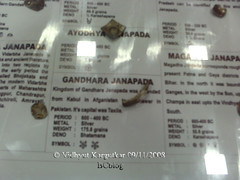owner Amol N. Bankar from wikipedia and http://www.geocities.com/ancientcoinsofindia/
Gandhara Janapada
Kingdom of Gandhara Janapada was extended from Kabul in Afganistan to Peshawar in Pakistan. Its capital was Taxila.
period: 600 - 400 B.C.
metal: silver
weight: 175.8 grains
deno: Shatamana
By the way the flower symbol that one can see in the picture is located inside the curvy part. So i had to bend over and see it. I tried to take a picture but it didnt come out! :(
Legend:
From the Mahabharata:
The wool of Gandharis is referred to in the Rigveda. The Gandharis, along with the Mujavantas, Angas and the Magadhas, are also mentioned in the Atharvaveda, but apparently as a despised people. Gandharas are included in the Uttarapatha division of Puranic and Buddhistic traditions. Aitareya Brahmana refers to king Naganajit of Gandhara who was contemporary of raja Janaka of Videha. According to Dr Zimmer, Gandharas were settled since the Vedic times on the south bank of river Kubha (Kabol) up to its mouth into Indus itself. Later the Gandharas crossed Indus and expanded into parts of north-west Panjab. Gandharas and their king figure prominently as strong allies of the Kurus against the Pandavas in Mahabharata war. The Gandharas were a furious people, well trained in the art of war.
The Gandhara kingdom sometimes also included Kashmira [8]. Hecataeus of Miletus (549-468) refers to Kaspapyros (Kasyapura i.e Kashmira) as Gandharic city. According to Gandhara Jataka, at one time, Gandhara formed a part of the kingdom of Kashmir.
The Gandhara kingdom sometimes also included Kashmira [8]. Hecataeus of Miletus (549-468) refers to Kaspapyros (Kasyapura i.e Kashmira) as Gandharic city. According to Gandhara Jataka, at one time, Gandhara formed a part of the kingdom of Kashmir.
The boundaries of Gandhara varied throughout history. Sometimes the Peshawar valley and Taxila were collectively referred to as Gandhara and sometimes the Swat valley (Sanskrit: Suvāstu) was also included. The heart of Gandhara however was always the Peshawar valley. The kingdom was ruled from capitals at Pushkalavati (Charsadda), Taxila, Purushapura (Peshawar) and in its final days from Udabhandapura (Hund) on the Indus. According to the Puranas, they have been named after Taksha and Pushkara, the two sons of Bharata, a king of Ayodhya.
In the Mahabharat the wife of Kuru King Dhritarashtra was Gandhari, the daughter of Subala or Suvala. Gandhara prince Sakuni was the root of all the conspiracies of Duryodhana against the Pandavas, which finally resulted in the Kurushketra war. Sakuni's sister was the wife of the Kuru king Dhritarashtra.
Takshasila was founded by Raghava Rama's brother Bharata. Bharata's descendants ruled this kingdom afterwards. During epic period it was ruled by Sakuni's father Suvala, Sakuni and Sakuni's son. Arjuna defeated Sakuni's son Uluka during his post-war military campaign for Yudhishtira's Ashwamedha Yagna.











No comments:
Post a Comment